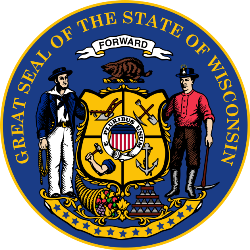Wisconsin Producing Nail-Biter Presidential Elections at Historic Rate
Wisconsin became just the second state in history (and first in 120 years) to host elections for the White House decided by less than one point in three out of five cycles

As Smart Politics highlighted earlier this week, Wisconsin is no stranger to plurality-winning elections, and among those are several that have been very closely decided over the past few decades.
And while Ohio has justifiably been called the nation’s bellwether state, in the 21st Century Wisconsin has been the quintessential battleground state.
In fact, when looking at razor-thin presidential races across the country, Wisconsin is producing them at a rate that has never been eclipsed in U.S. history.
Smart Politics examined the more than 2,000 statewide presidential elections conducted since 1828 and found that Wisconsin is just the second state to host contests decided by less than one point in three out of five cycles, and the first since the 1890s.
Overall, 86 statewide presidential elections have been decided by less than one percentage point since the modern two-party era began 48 cycles ago in 1828, or 4.2 percent of such elections.
Wisconsin has hosted three of them – all in the 21st Century.
In 2000, Al Gore defeated George W. Bush in the Badger State by 0.22 points – the third closest race in the nation behind Florida (0.01) and New Mexico (0.06).
In 2004, John Kerry carried Wisconsin by 0.38 points over President Bush – the most closely decided election in the country that cycle.
Last month, Donald Trump edged Hillary Clinton by 0.81 points – the third narrowest victory margin around the country behind Michigan (0.22) and New Hampshire (0.37).
Prior to Wisconsin, only one other state has produced so many nail-biters in a 16-year (five cycle) stretch – California.
The Golden State backed Democrat Winfield Hancock over James Garfield by 0.09 points in 1880, Democrat Grover Cleveland by 0.05 points over President Benjamin Harrison in 1892, and Republican William McKinley by 0.64 points over William Jennings Bryan in 1896.
California has the highest number (nine) and rate (21.4 percent) of presidential elections decided by less than a point in the modern two-party era, doing so in 1860, 1868, 1880, 1892, 1896, 1912, 1916, 1948, and 1960.
After California, Maryland has the next highest rate of razor-thin victory margins with 12.5 percent decided by less than a point (6 of 48 elections since 1828), followed by New Mexico at 11.1 percent (3 of 27), Missouri at 10.4 percent (5 of 48), Kentucky and Ohio at 8.3 percent (4 of 48), Oregon at 7.5 percent (3 of 40), and Wisconsin at 7.0 percent (3 of 43).
With its nail-biters in 2000 and 2004, Wisconsin became one of nine states to see its presidential race decided by less than a percentage point in back-to-back cycles:
- California: 1892 (Grover Cleveland, 0.05 points) and 1896 (William McKinley, 0.64); 1912 (Teddy Roosevelt, 0.02) and 1916 (Woodrow Wilson, 0.38)
- Connecticut: 1884 (Cleveland, 0.94) and 1888 (Cleveland, 0.22)
- Iowa: 2000 (Gore, 0.31) and 2004 (Bush, 0.67)
- Maryland: 1828 (John Quincy Adams, 0.51) and 1832 (Henry Clay, 0.01); 1904 (T. Roosevelt, 0.02) and 1908 (William Taft, 0.25)
- Missouri: 1956 (Adlai Stevenson, 0.22) and 1960 (John Kennedy, 0.52)
- New Mexico: 2000 (Gore, 0.06) and 2004 (Bush, 0.79)
- Ohio: 1944 (Thomas Dewey, 0.37) and 1948 (Harry Truman, 0.24)
- Tennessee: 1952 (Dwight Eisenhower, 0.27) and 1956 (Eisenhower, 0.62)
Although the nation is at its lowest rate of seeing states flip their partisan preference in presidential elections – there has been a higher than usual rate of very close statewide races.
Over the last five cycles since 2000, there have been 14 states carried by less than a point (5.5 percent).
That is the highest level in more than half a century – last eclipsed in 1948 through 1964 with 16 states (6.5 percent).
Over the last century, the only other five-cycle stretch with more ultra competitive presidential contests was 1944 to 1960 (16, 6.6 percent).
Follow Smart Politics on Twitter.

Twenty-first (21) Century: a) Gore’s tissue-thin win over GW in WI occurred at the end of the 20th Century – though the ensuing four-year term does commence on the 20th day of the following century; b) With this election, the Buckeye State more likely than not seems to have relinquished its title as THE -or even A- battleground/bellweather state; not only did it stray from the plus-or-minus-3% state vote shares within the pricipal candidates’ national vote percentages (from 1964 through 2012), but also absent are the sufficiently sizable non-“Anglo” voting populations (AZ, even TX) and any sufficiently massive metropolitan colossus (Washington-Baltimore, even “Twin Cities” of VA and MN, respectively).